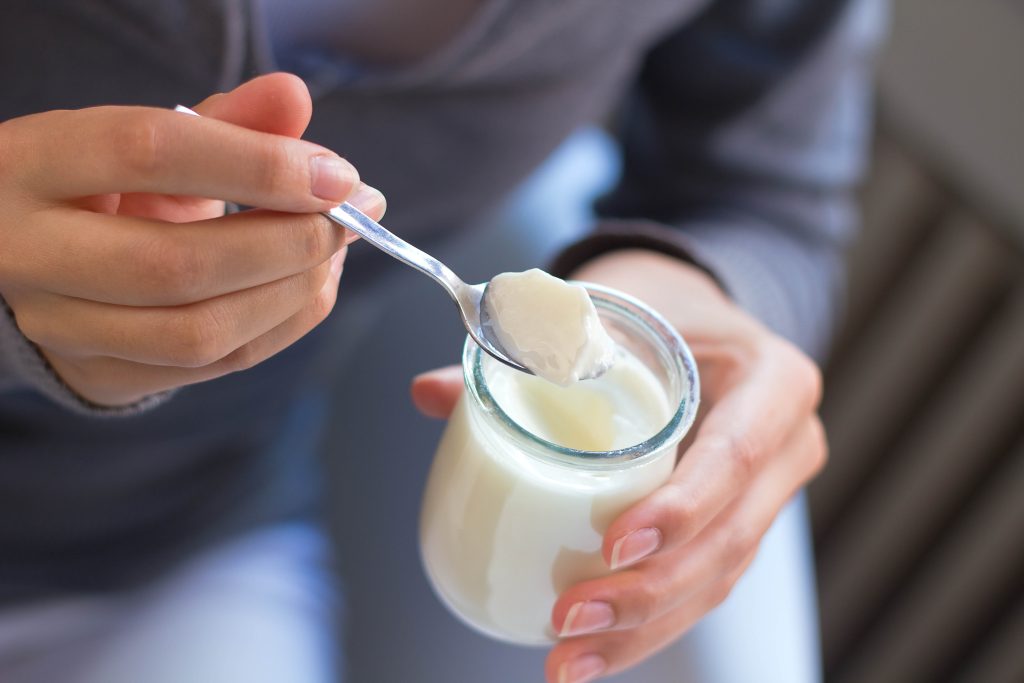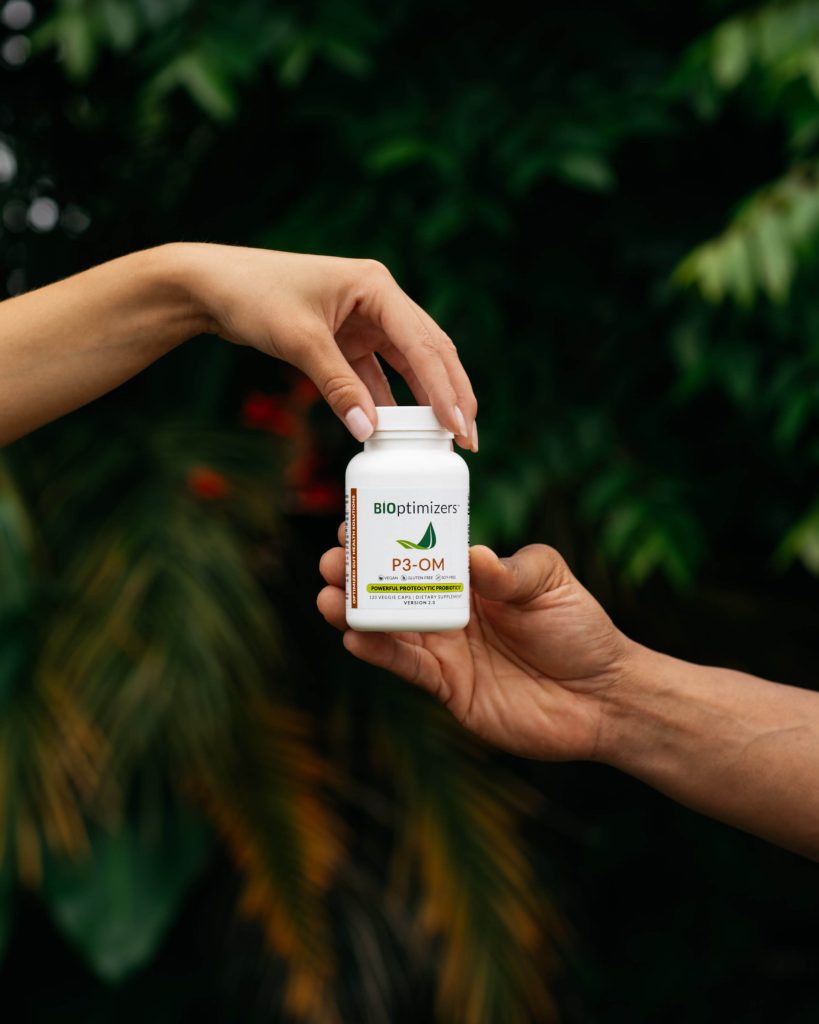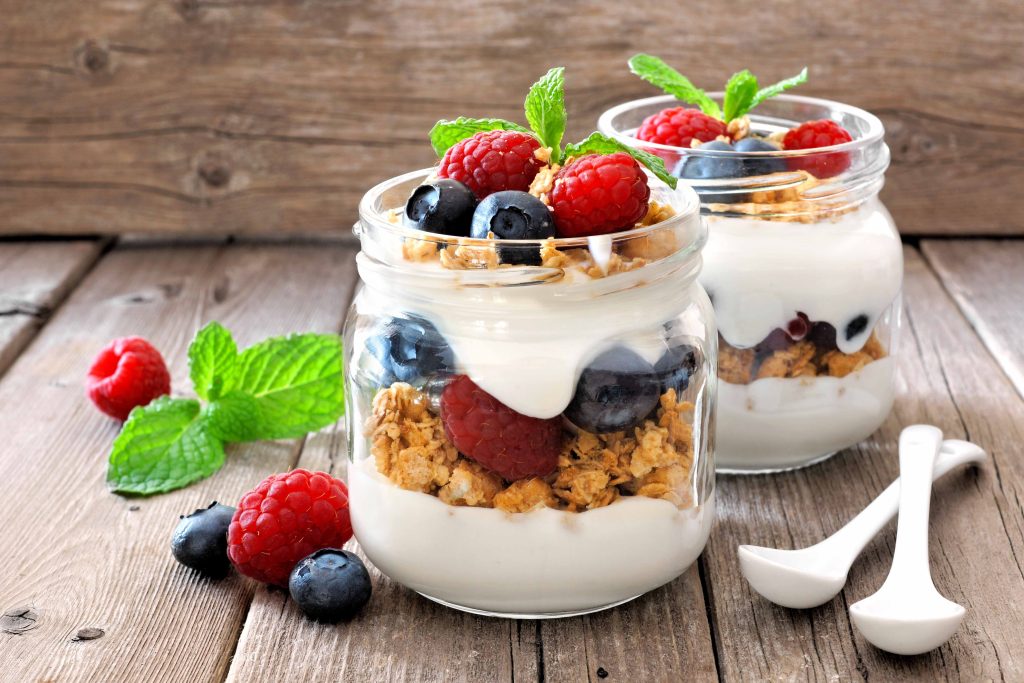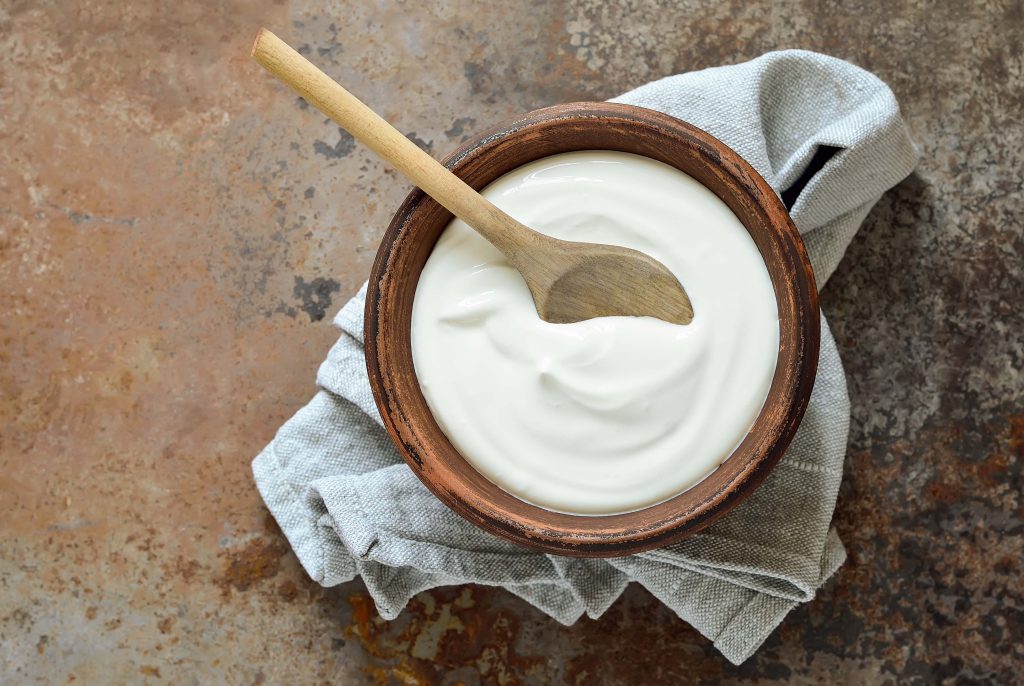
Can You Take Yogurt for Probiotics?


Can You Take Yogurt for Probiotics?
Of all the probiotic foods available today, yogurt stands out as the most popular and easily accessible option, as they’re in supermarkets everywhere and even in gas stations. Yogurt companies have long advertised their products as a source of probiotics for gut health.
But can the ubiquitous yogurt deliver on its probiotic promise? This article will explore the science behind yogurt and probiotics and evaluate whether your favorite dairy snack is the best option for getting your daily dose of healthy bacteria.

Is Yogurt a Good Source of Probiotics?
The history of yogurt is fascinating, dating back to ancient times 5,000-10,000 BC when it was serendipitously discovered by shepherds transporting milk in intestinal sacks. The remaining intestinal secretions caused the milk to ferment, making it thicken and sour, and preserving it for much longer than fresh milk.
Famous ancient figures such as Abraham credited yogurt with his long life and many children, while early scientists like Hippocrates saw fermented milk as medicine and correctly suggested it for stomach and bowel problems.
While yogurt is an excellent probiotic carrier and provides nutritional benefits, modern-day supermarket yogurt is not the best source of probiotics. Let’s explore why.
1. Store-Bought Yogurt Is Often Pasteurized After Fermentation
Yogurt owes its probiotic properties to the fermentation process, during which lactic acid bacteria, such as Lactobacillus and Bifidobacterium species, break down lactose (a sugar found in milk) into lactic acid. The lactic acid lowers the pH of the milk, which causes milk proteins to coagulate. This process also enriches it with live cultures of probiotics.
However, a potential drawback of commercially produced yogurt is that it typically undergoes pasteurization after fermentation. While pasteurization is necessary to kill pathogens, it can also eliminate beneficial bacteria, potentially reducing the yogurt’s probiotic health benefits.
A study compared the effects of pasteurized and unpasteurized yogurt on antibiotic-induced diarrhea. Participants consumed 200 grams of either pasteurized or unpasteurized yogurt containing:
- Lactobacillus rhamnosus GG (LGG)
- Bifidobacterium lactis
- Lactobacillus acidophilus
Participants who consumed unpasteurized yogurt had no severe diarrhea and only one minor diarrhea episode. In the group consuming pasteurized yogurt, however, there were six severe and 21 instances of minor diarrhea. Additionally, the non-pasteurized probiotic group experienced fewer issues like abdominal pain, vomiting, and headaches.
Fortunately, some manufacturers prepare store-bought yogurts by pasteurizing milk before fermentation, allowing the benefit of live probiotics. When choosing yogurt with probiotics, look for labels that say “live and active cultures” or “contains live cultures.”
However, there is no guarantee that all cultures survive until you consume the food. The amount of probiotic strains in foods depends on factors like ingredients, cultures, processing, temperature, aeration, packaging, storage, and transportation.

2. Reduced or Insufficient Potency
To get the health benefits of bacteria-based probiotics like Lactobacillus and Bifidobacteria, commonly found in yogurt, consuming at least 10 billion CFUs/g (Colony Forming Units per gram) is recommended. This ensures that 6-7 billion CFUs reach your colon.
A systematic review examined studies and probiotic products in the Canadian market. They found that several clinical trials that examined the benefits of bacteria strains used doses 2 – 25 times higher than doses typically found in supermarket yogurts.
Therefore, assuming that the yogurts are not pasteurized after fermentation and kept in perfect conditions, a single serving is typically too low a dose to make a difference in your health.
3. Probiotic Strain Limitations
It’s important to note that numerous probiotic strains are available, each targeting specific health needs. According to the FDA, manufacturers prepare yogurt using Lactobacillus delbrueckii subspecies bulgaricus and Streptococcus thermophilus. However, yogurt often contains a mix of bacterial cultures added after fermentation. This general mix means you may not be consuming the precise strains most effective for your particular health requirements.
In a recent comprehensive review of studies, researchers highlighted several probiotic strains for their established health benefits: (spoiler alert – it’s tough to find these by picking up some yogurt at the store!)
| Function | Strain(s) or Species |
| Aids in maintaining intestinal balance | Lacticaseibacillus casei |
| Helps regulate gut and immune responses | Bifidobacterium infantis |
| Improves digestive health | Lactiplantibacillus plantarum |
| Modulates immune responses | Enterococcus faecium, Streptococcus thermophilus |
| Supports digestive and immune health | Bifidobacterium longum, Lactobacillus rhamnosus, Lactobacillus acidophilus |
| Supports digestive and maternal health | Lactobacillus acidophilus |
| Supports gut health | Lactobacillus reuteri, Streptococcus thermophilus |
| Supports immune system | Bifidobacterium bifidum |
| Supports oral health | Lactobacillus reuteri |
| Treats diarrhea and digestive issues | Saccharomyces boulardi, Bacillus subtilis |
| Regulates intestinal microbiota and boosts immunity | Bacillus coagulans |
You can explore more specific probiotic benefits in our collection of articles here.
Probiotics’ survival during passage through the gastrointestinal tract is crucial for preserving their health-promoting effects. Certain probiotic strains or preparations are more likely to withstand the harsh conditions of the digestive system, such as stomach acid, ensuring you can fully reap their benefits.
A study explored the survival of probiotics in commercially prepared yogurt in the gut. Participants ate 125 grams of yogurt twice a day for one week, taking in around 6 billion CFUs L. delbrueckii and 50 billion CFUs S. thermophilius daily. Researchers then examined the feces to determine what probiotics survived digestion.
After one week, researchers identified L. delbrueckii in the feces of six out of ten volunteers but no S. thermophilius.
The good news for yogurt is that fat globules in fermented milk may help protect probiotics from stomach acid. However, the effectiveness of this protection is contingent on factors such as storage and transport.
Probiotic supplements have the advantage of being specially designed to survive the harsh digestive environment. Packaging probiotics in special microcapsules creates a protective coating that shields them from stomach acid, preserving their effectiveness.
You can learn more about how probiotics survive stomach acid in this article.

4. Food Sensitivities/Intolerance
While experts often recommend yogurt as a probiotic source, some individuals may need to avoid it due to specific food sensitivities or intolerances related to consuming yogurt.
Lactose Intolerance
While some people may have an easier time with dairy in the form of yogurt, if you are lactose intolerant or have a dairy allergy, taking a probiotic supplement is likely a better option.
Lactose intolerance means your body has difficulty digesting lactose, a sugar in milk and dairy products. This occurs due to a deficiency in lactase, the enzyme responsible for breaking down lactose in the digestive system. Lactose isn’t adequately digested without sufficient lactase, leading to gastrointestinal symptoms.
The good news for those with lactose intolerance is that yogurt might be okay. The lactic acid bacteria in yogurt can help you break down lactose. The bacterial lactase (B-galactosidase) in yogurt also survives stomach acid and remains active in the intestines, aided by yogurt’s buffering properties and slower digestion time.
A review of seven controlled trials found that yogurt with live active cultures can enhance lactose digestion and significantly reduce symptoms of lactose intolerance.
However, some people with lactose intolerance do react to yogurt anyway, so you need to know your own response and which yogurt you tolerate. Some may also consume dairy and yogurt with lactase or a digestive enzyme supplement that has lactase, such as MassZymes or Gluten Guardian.
Increased Mucus Production
For some people, consuming dairy may increase mucus production in the respiratory tract, causing more runny nose or phlegm. This is more likely with A1 milk, a type of cow’s milk containing a specific protein variant called A1 beta-casein. It’s the most widely available milk and is commonly used for yogurt.
When broken down in the human colon, A1 milk produces beta-casomorphin-7 (beta-CM-7). This substance then triggers the glands in the gut to produce more mucus. If beta-CM-7 gets into the blood, it may also cause your respiratory glands to make and release more mucus.
A study of over 100 people with excess mucus in their noses and throats examined the link between dairy consumption and mucus symptoms. For the first six days, everyone followed a dairy-free diet. During the last four days, half received dairy supplements, and half received non-dairy supplements.
Initially, mucus levels decreased for everyone on the dairy-free diet. After introducing supplements, those taking dairy supplements saw a significant increase in mucus, while those taking non-dairy supplements maintained reduced mucus levels. This suggests that dairy consumption can increase mucus production while avoiding dairy helps reduce it.
Histamine Sensitivity
People sensitive to histamines or biogenic amines should avoid yogurt as a probiotic source because lactic acid bacteria can produce biogenic amines. Biogenic amines, including histamine, are natural compounds found in various foods, and microbial activity can increase their levels during food processing and storage.
Histamine intolerance occurs when you cannot break down histamine in foods, so you absorb most of the histamine when consuming foods high in histamine. So, foods like yogurt, soy sauce, wine, and chocolate can cause unpleasant reactions.
This kind of sensitivity can be hard to identify because your reaction to the same histamine may sometimes differ. It’s important to pay attention to your body. Keeping a food diary may help you identify trends and possible culprits. Some typical symptoms include:
- Flushed skin or rash
- Sneezing, congestion
- Headache, dizziness
- Diarrhea, vomiting, abdominal pain
- Constipation
- Heart palpitations
Managing histamines usually means following a low-histamine diet, including avoiding foods high in biogenic amines to reduce symptoms. Bacteria widely used in the fermentation of yogurt, L. delbrueckii, S. thermophilus, and various strains of Lactobacillus, can produce histamines along with many of the live cultures added after pasteurization, making yogurt a high-histamine food.
Which Yogurts Are Highest in Probiotics?
If you tolerate yogurt or fermented dairy and want to eat them as a food source of probiotics, make sure they have sufficient potency for your health goals.
Kefir, most commonly made with milk, tastes similar to yogurt but is prepared differently and has a more liquid drinkable consistency. To make kefir, you add kefir grains (which look a bit like cauliflower but have a gummy bear-like texture) to milk and leave it to ferment between 12 and 48 hours, depending on the room’s temperature. Whereas, yogurt just needs another yogurt to start and takes less time to ferment.
Kefir grains contain up to 61 strains of probiotic yeast and bacteria, offering more probiotic benefits than the two to six probiotic strains found in yogurt and giving you a bigger bang for your buck (probiotically speaking).
If kefir just isn’t your thing, you can still make choices to help maximize the probiotic benefits of commercially produced yogurt. Always choose yogurt (and kefir) pasteurized before, not after, fermentation. The next best option is to ensure that producers state on the package that they added live cultures after pasteurization.
Choosing varieties with fruit may affect the survival of L. acidophilus. A study where researchers added 5% or 10% of fruit to yogurt found that yogurts with 10g of passion fruit or mixed berries had a bigger drop in L. acidophilus bacteria than plain yogurt. Yogurt with added spirulina, however, may help ensure the survival of L. acidophilus.
A study found that mixing in spirulina increased the L. acidophilus content by 30%. It may promote probiotic bacteria growth by providing essential compounds such as adenine, hypoxanthine, and free amino acids to these microorganisms.
Whichever you prefer, you’ll likely get the most probiotic benefits from homemade kefir and yogurt. Not only do you control the ingredients and the bacteria strains, but homemade versions often contain higher levels of live cultures than commercial varieties, providing greater probiotic benefits. You also decrease the risk of probiotic loss through processing, transportation, and storage.

You can even make your own yogurt from our best probiotic, Probiotic Breakthrough containing L. plantarum. Here’s a recipe to try out:
Ingredients:
- 4 cups of milk (cow’s, coconut, blended coconut meat, or cashew milk)
- 2 capsules Probiotic Breakthrough
Instructions:
- Heat the milk in a saucepan until it reaches 180°F (82°C), then let it cool to 110°F (43°C).
- Stir the contents of 2 Probiotic Breakthrough capsules into the cooled milk.
- Cover the mixture in a clean glass jar and incubate at 110°F (43°C) for 6 to 12 hours. I often wrap my yogurt in a fleece blanket and then place it in a warm place. You can also use a yogurt maker or the yogurt-making function of an automated pot like the Instant Pot.
- Check the yogurt’s consistency and refrigerate it once it’s ready.
- Adjust the ingredients and time according to your preference. The consistency and flavor will vary depending on the milk you use.
Can You Take Probiotics and Eat Yogurt at the Same Time?
Yes, you can take probiotics and eat yogurt at the same time. Combining probiotic supplements with yogurt can enhance the overall intake of beneficial bacteria since both sources provide different strains that support health.
Yogurt typically contains strains like L. bulgaricus and S. thermophilus (along with any strain added after fermentation), while probiotic supplements offer a wider variety of strains. Consuming both can introduce a broader range of beneficial bacteria to your gut and allow you to choose the strains you want for targeted health benefits. Additionally, adding probiotics to yogurt may help protect them from stomach acid due to the fat globules.
Beyond probiotics, yogurt provides valuable nutrients such as calcium, protein, and vitamins, contributing to overall health. While it’s generally safe to consume probiotics and yogurt simultaneously, it’s always wise to consult with a healthcare professional, especially if you have specific health conditions or concerns, to ensure this approach suits your needs.
Best Time to Consume Probiotics and Yogurt
The best time of day to get in your probiotics is whatever time you won’t forget. Beyond that, to maximize the chance of survival, taking probiotic supplements is probably best on an empty stomach to allow them to withstand the acidity of your stomach and reach the intestines.
As mentioned before, taking probiotics with yogurt may improve their survival in the digestive system due to the fat content.
As a food, yogurt can fulfill other health goals, if you tolerate it.
If your goal is to curb hunger, you may want to also incorporate yogurt into your day as a high-protein snack. A study of twenty healthy women explored which foods provide the most appetite control. Participants ate a high-protein yogurt, high-fat crackers, or high-fat chocolate snack three hours after lunch for three days.
Eating yogurt helped people feel less hungry in the afternoon. After eating yogurt, they waited about 30 minutes longer to eat again than when they ate chocolate and about 20 minutes longer than when they ate crackers. Additionally, people consumed about 100 fewer calories at dinner after having yogurt compared to crackers or chocolate.

If your goal is muscle gain, incorporating Greek yogurt into your diet three times a day could be highly effective. A study involving 30 untrained men examined the impact of Greek yogurt on strength, muscle thickness, and body composition.
Participants consumed fat-free, plain Greek yogurt or a carbohydrate-based placebo pudding three times a day.
After 12 weeks, both groups improved muscle strength, thickness, and fat-free mass. However, the Greek yogurt group experienced significantly greater gains in all these areas than the placebo group.
Learn more about the best time to take probiotics in this article.
How to Choose Yogurt and Probiotic Supplements for Maximum Benefits
If you’re ready to incorporate yogurt and probiotics into your daily routine, here are some tips to ensure you get the maximum benefits:
- Choose Researched Strains: Opt for yogurt and probiotic supplements that contain strains of bacteria that are scientifically researched and proven effective, like Probiotic Breakthrough.
- Check Pasteurization Timing: Select yogurt pasteurized before fermentation, not after, to ensure that the live cultures remain active.
- Ensure Supplement Survival: Probiotic supplements should be formulated to withstand stomach acid. For more information, check out this article on how probiotics survive stomach acid here.
- Opt for Reliable Sources: For the most reliable source of probiotics or specific health goals, consider taking a researched probiotic supplement like Probiotic Breakthrough or Microbiome Breakthrough, which provides a wide array of health benefits and undergoes regular testing to ensure viability.
- DIY Probiotics: You can enhance your yogurt by opening a probiotic capsule like Probiotic Breakthrough and mixing it or making your own yogurt with the above recipe.
Conclusion
While commercial yogurt is a popular and accessible source of probiotics, its efficacy can be hindered by factors like pasteurization, storage conditions, and limited probiotic strains. Probiotic supplements, particularly those formulated for survivability consistency, offer a more reliable option for probiotic intake. Making informed choices, whether in selecting yogurt or probiotic supplements, is crucial for maximizing probiotic benefits and supporting overall health.
References
- Hadjimbei E, Botsaris G, Chrysostomou S. Beneficial effects of yoghurts and probiotic fermented milks and their functional food potential. Foods. 2022;11(17):2691. doi:10.3390/foods11172691
- Fox MJ, Ahuja KDK, Robertson IK, Ball MJ, Eri RD. Can probiotic yogurt prevent diarrhoea in children on antibiotics? A double-blind, randomised, placebo-controlled study. BMJ Open. 2015;5(1):e006474. doi:10.1136/bmjopen-2014-006474
- Naissinger da Silva M, Tagliapietra BL, Flores V do A, Pereira dos Santos Richards NS. In vitro test to evaluate survival in the gastrointestinal tract of commercial probiotics. Curr Res Food Sci. 2021;4:320-325. doi:10.1016/j.crfs.2021.04.006
- Scourboutakos M, Franco-Arellano B, Murphy S, Norsen S, Comelli E, L’Abbé M. Mismatch between probiotic benefits in trials versus food products. Nutrients. 2017;9(4):400. doi:10.3390/nu9040400
- Maftei NM, Raileanu CR, Balta AA, et al. The potential impact of probiotics on human health: An update on their health-promoting properties. Microorganisms. 2024;12(2):234. doi:10.3390/microorganisms12020234
- Elli M, Callegari ML, Ferrari S, et al. Survival of yogurt bacteria in the human gut. Appl Environ Microbiol. 2006;72(7):5113-5117. doi:10.1128/aem.02950-05
- Huq T, Khan A, Khan RA, Riedl B, Lacroix M. Encapsulation of probiotic bacteria in biopolymeric system. Crit Rev Food Sci Nutr. 2013;53(9):909-916. doi:10.1080/10408398.2011.573152
- Savaiano DA, Hutkins RW. Yogurt, cultured fermented milk, and health: a systematic review. Nutr Rev. 2021;79(5):599-614. doi:10.1093/nutrit/nuaa013
- Bartley J, McGlashan SR. Does milk increase mucus production? Med Hypotheses. 2010;74(4):732-734. doi:10.1016/j.mehy.2009.10.044
- Frosh A, Cruz C, Wellsted D, Stephens J. Effect of a dairy diet on nasopharyngeal mucus secretion. Laryngoscope. 2019;129(1):13-17. doi:10.1002/lary.27287
- Hrubisko M, Danis R, Huorka M, Wawruch M. Histamine intolerance—the more we know the less we know. A review. Nutrients. 2021;13(7):2228. doi:10.3390/nu13072228
- Bourrie BCT, Willing BP, Cotter PD. The Microbiota and health promoting characteristics of the fermented beverage Kefir. Front Microbiol. 2016;7. doi:10.3389/fmicb.2016.00647
- Kailasapathy K, Harmstorf I, Phillips M. Survival of Lactobacillus acidophilus and Bifidobacterium animalis ssp. lactis in stirred fruit yogurts. Lebenson Wiss Technol. 2008;41(7):1317-1322. doi:10.1016/j.lwt.2007.08.009
- Patel P, Jethani H, Radha C, et al. Development of a carotenoid enriched probiotic yogurt from fresh biomass of Spirulina and its characterization. J Food Sci Technol. 2019;56(8):3721-3731. doi:10.1007/s13197-019-03844-0
- Tompkins T, Mainville I, Arcand Y. The impact of meals on a probiotic during transit through a model of the human upper gastrointestinal tract. Benef Microbes. 2011;2(4):295-303. doi:10.3920/bm2011.0022
- Ortinau LC, Hoertel HA, Douglas SM, Leidy HJ. Effects of high-protein vs. high- fat snacks on appetite control, satiety, and eating initiation in healthy women. Nutr J. 2014;13(1). doi:10.1186/1475-2891-13-97
- Bridge A, Brown J, Snider H, et al. Greek yogurt and 12 weeks of exercise training on strength, muscle thickness and body composition in lean, untrained, university-aged males. Front Nutr. 2019;6. doi:10.3389/fnut.2019.00055






